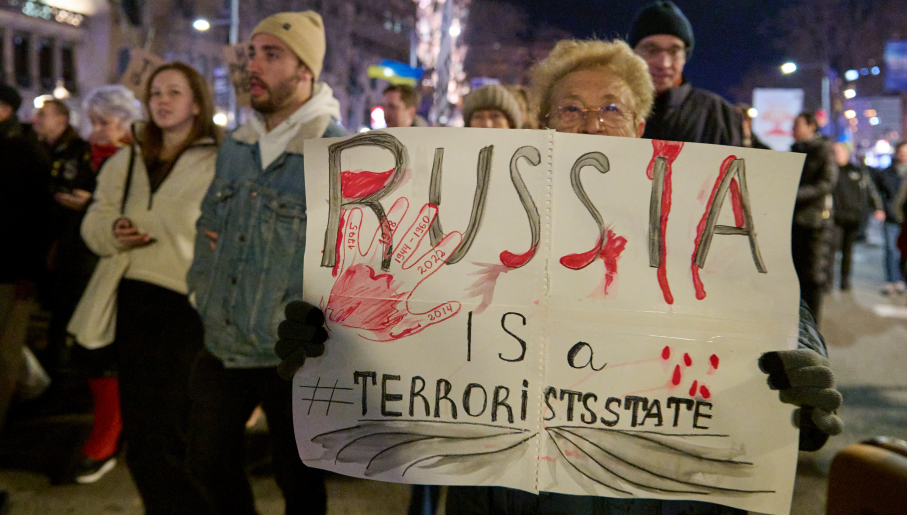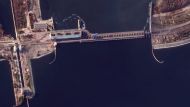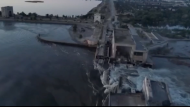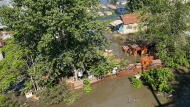aa/kb 06.06.2023,

Photo: Lorena Sopena/Europa Press via Getty Images.
Ukraine accused Russia on Tuesday, June 6, of blowing up the Nova Kakhovka dam on the Dnipro River that separates Russian and Ukrainian forces in southern Ukraine, inundating a populated region of the war zone and forcing villagers to flee.

Russians blow up dam in occupied city, Kherson at risk of flooding
Kyiv on Tuesday accused Russia of blowing up a dam and causing widespread flooding in southern Ukraine. About 80 settlements are at risk of...see more
The Ukrainian prosecutor general’s office said on Tuesday it was investigating the blast at the Nova Kakhovka dam, situated in Russian-occupied territory, as a war crime and as a possible act of environmental destruction, or “ecocide.”
Russia had conducted a winter campaign of air strikes on Ukrainian energy and utilities infrastructure, damaging up to 50 percent of the energy infrastructure. Kyiv said this constitutes a war crime, while Moscow said the targets were legitimate.
The Geneva Conventions and its protocols explicitly ban war-time attacks on “installations containing dangerous forces” such as dams due to the risk posed to civilians, a prohibition likely to come into focus after the destruction of the huge Ukrainian dam.
Attack on a dam: What kind of crime?
The 1949 Geneva Convention’s subsequent protocols specifically cover attacks on “installations containing dangerous forces”, such as hydroelectric dams. Such installations should not be attacked even if they are legitimate military objectives, “if such attack may cause the release of dangerous forces and consequent severe losses among the civilian population”, the protocols, dating from 1977 say.
There is no mention of dams in the 1998 founding statute of the International Criminal Court. But the statute does criminalize “intentionally launching an attack in the knowledge that such attack will cause incidental loss of life or injury to civilians or damage to civilian objects or widespread, long-term and severe damage to the natural environment which would be clearly excessive in relation to the concrete and direct overall military advantage anticipated.”
In a blog for the European Journal of International law on Tuesday, international law professor Marko Milanović of the University of Reading said the dam’s destruction could amount to a war crime, or the graver offense of a crime against humanity, if it was carried out by Russia - “knowing of the harm that can befall the civilian population.”
What does International Law say?
The Geneva Conventions and additional protocols shaped by international courts say that parties involved in a military conflict must distinguish between “civilian objects and military objectives”, and that attacks on civilian objects are forbidden.
This prohibition is also codified in the Rome Statute of the ICC, which opened an investigation into possible war crimes in Ukraine soon after Russia’s February 2022 invasion, and has been examining the attacks on infrastructure.
The prohibition seems clear-cut however some infrastructure owned and used by civilians can also be classified a military objective. Military objectives are defined as “those objects which by their nature, location, purpose or use make an effective contribution to military action”, and whose destruction or capture “offers a definite military advantage”.

Polish Foreign Ministry condemns Russia’s attack on Nova Kakhovka dam
Referring to the recent attack on the Nova Kakhovka dam, Poland’s Foreign Ministry “absolutely” condemned “another unprecedented act of Russian...see more
Energy infrastructure: military or civilian?
Power infrastructure has long been considered a valid military objective as long as it supports an enemy army’s activities, even if the system also supports the civilian population, writes military law expert Michael Schmitt in the Articles of War blog run by the Lieber Institute for Law & Warfare at the United States Military Academy West Point.
Milanović said a dam “is not a military objective by its nature, but it may be such by its purpose or use.”
In his blog he added: “The real question here is whether the dam was making ‘an effective contribution to military action’.”
How military needs are balanced against civilian
But even if some targets could be considered military objectives, that is not the end of the story, says Katharine Fortin, associate professor of international law at Utrecht University.
The military must consider whether the damage and loss incurred by civilians in such attacks are excessive compared to the concrete and direct military advantage, she said.
Milanović makes a similar argument. He says that even if a dam could be seen as a military objective, an attack could be legally classified as disproportionate - for instance, if the incidental loss of civilian life or damage to civilian objects is excessive when examining the direct military advantage expected.
source: REUTERS
Destroyed dam likely to hinder Ukraine before Russia

Moscow and Kyiv traded blame for the damage to the Kakhovka dam
FLOODS AS A WEAPON OF WAR
The risk of strikes on the strategic Kakhovka facility, located in the Russian-occupied areas of the Kherson region, has been brandished since October by both Ukrainians and Russians.
Ukraine President Volodymyr Zelensky accused Moscow of having "undermined the dam", one of the largest in Ukraine. Russian authorities retorted: "lies".
Destruction of this magnitude, likely to cause considerable harm to civilians, is considered a war crime under the 1949 Additional Protocols to the Geneva Convention.
"Dams, dykes and nuclear electrical generating stations, shall not be made the object of attack, even where these objects are military objectives, if such attack may cause the release of dangerous forces and consequent severe losses among the civilian population," according to Article 56.
Contemporary history offers many examples of the destruction of dams and floods in Europe for defensive and offensive purposes.
In 1941, the Soviet Union blew up a huge dam in Ukraine's Zaporizhzhia to slow the German advance.
In May 1943, the British Royal Air Force bombed German dams in the Ruhr valley, the country's industrial heartland.
Carried out by the RAF squadron 617 - which earned the nickname "Dambusters" -- this operation destroyed two of three dams and damaged the third.
The effort was immortalised in the 1955 film "The Dam Busters".
The flooding tactic was also practised in the First World War.
In the autumn of 1914, during the Battle of Yser, French and Belgian forces unleashed floods to slow the advance of German troops who were attempted in cross the Yser River toward Dunkirk.
The flooding was orchestrated by tampering with the system of locks in Nieuwpoort, which regulates the influx of seawater and drainage to flood plains.

Moscow and Kyiv traded blame for the damage to the Kakhovka dam
(Photo: AFP/STRINGER)
07 Jun 2023
PARIS: The gaping hole blasted into a key hydroelectric dam in southern Ukraine on Tuesday (Jun 6) will severely impede Kyiv's efforts to reconquer territory lost to Russia, even if Moscow risks seeing its defensive lines submerged.
Moscow and Kyiv traded blame for the damage to the Kakhovka dam, which is designed to supply water to the Crimean Peninsula, annexed by Moscow in 2014, which could now be facing serious water supply problems.
But Western observers believe the sabotage is a Russian attempt to harm Kyiv in the short term, just as Ukraine prepares to launch a counteroffensive to regain areas in the east.
Kyiv shares the same view, having accused Russia of having "blown up" the dam in order to "slow down" its operation.
Floods have already forced thousands to evacuate and risks interrupting ongoing Ukrainian military operations.
The rising water in the Kherson region will make it very difficult for Ukraine forces to carry out any operation involving crossing the river to reclaim the eastern bank, in the direction of Crimea.
"Following the logic of cui bono (who benefits), Russia would be the obvious culprit, since by causing floods downstream of Nova Kakhovka, the Russians would complicate Ukraine's efforts to cross, winning time, which would allow them to focus on other sections of the front," said Sergey Radchenko, a history professor at Johns Hopkins School of Advanced International Studies, in a Twitter post.
"I can't see anything near beneficial to Ukraine in this case. More destroyed infrastructure, more downed electricity production facilities, more suffering for Ukrainian civilians, a limitation of Ukrainian offensive and logistics options," said Stephane Audrand, an independent consultant on international risks.
07 Jun 2023
PARIS: The gaping hole blasted into a key hydroelectric dam in southern Ukraine on Tuesday (Jun 6) will severely impede Kyiv's efforts to reconquer territory lost to Russia, even if Moscow risks seeing its defensive lines submerged.
Moscow and Kyiv traded blame for the damage to the Kakhovka dam, which is designed to supply water to the Crimean Peninsula, annexed by Moscow in 2014, which could now be facing serious water supply problems.
But Western observers believe the sabotage is a Russian attempt to harm Kyiv in the short term, just as Ukraine prepares to launch a counteroffensive to regain areas in the east.
Kyiv shares the same view, having accused Russia of having "blown up" the dam in order to "slow down" its operation.
Floods have already forced thousands to evacuate and risks interrupting ongoing Ukrainian military operations.
The rising water in the Kherson region will make it very difficult for Ukraine forces to carry out any operation involving crossing the river to reclaim the eastern bank, in the direction of Crimea.
"Following the logic of cui bono (who benefits), Russia would be the obvious culprit, since by causing floods downstream of Nova Kakhovka, the Russians would complicate Ukraine's efforts to cross, winning time, which would allow them to focus on other sections of the front," said Sergey Radchenko, a history professor at Johns Hopkins School of Advanced International Studies, in a Twitter post.
"I can't see anything near beneficial to Ukraine in this case. More destroyed infrastructure, more downed electricity production facilities, more suffering for Ukrainian civilians, a limitation of Ukrainian offensive and logistics options," said Stephane Audrand, an independent consultant on international risks.
FLOODS AS A WEAPON OF WAR
The risk of strikes on the strategic Kakhovka facility, located in the Russian-occupied areas of the Kherson region, has been brandished since October by both Ukrainians and Russians.
Ukraine President Volodymyr Zelensky accused Moscow of having "undermined the dam", one of the largest in Ukraine. Russian authorities retorted: "lies".
Destruction of this magnitude, likely to cause considerable harm to civilians, is considered a war crime under the 1949 Additional Protocols to the Geneva Convention.
"Dams, dykes and nuclear electrical generating stations, shall not be made the object of attack, even where these objects are military objectives, if such attack may cause the release of dangerous forces and consequent severe losses among the civilian population," according to Article 56.
Contemporary history offers many examples of the destruction of dams and floods in Europe for defensive and offensive purposes.
In 1941, the Soviet Union blew up a huge dam in Ukraine's Zaporizhzhia to slow the German advance.
In May 1943, the British Royal Air Force bombed German dams in the Ruhr valley, the country's industrial heartland.
Carried out by the RAF squadron 617 - which earned the nickname "Dambusters" -- this operation destroyed two of three dams and damaged the third.
The effort was immortalised in the 1955 film "The Dam Busters".
The flooding tactic was also practised in the First World War.
In the autumn of 1914, during the Battle of Yser, French and Belgian forces unleashed floods to slow the advance of German troops who were attempted in cross the Yser River toward Dunkirk.
The flooding was orchestrated by tampering with the system of locks in Nieuwpoort, which regulates the influx of seawater and drainage to flood plains.
Kremlin continues its ‘glorious Soviet tradition’ of blowing up dams on retreat
Michał Woźniak 06.06.2023

Dnipro HPP destroyed by Soviet forces while retreating from advancing Germans, late 1941.

Russians have planted explosives inside the huge Nova Kakhovka dam, Zelenskyy says
Russia predictably now claims that the Kakhovka dam has been destroyed due to a Ukrainian attack. But Russians packed the dam full of explosives months ago, and Ukraine raised alarm about it.
The initial Russian reporting on what happened included denying that any explosion had occurred at all, followed by several contradictory narratives floating around simultaneously, until, the expected Kyiv blaming started suggesting that the dam was destroyed deliberately but the Russians did not realize the scale of the damage they wrought.
Those parroting the Kremlin talking points immediately pointed out, that the destruction of the dam will result in Crimea losing its water supply. And after all, why would Russia willingly cut off the supply of water to Crimea if one of the reasons for launching the full-scale invasion was to unblock the supply of water flowing into the peninsula through the North Crimea Canal?

Russians shell evacuees, no drinking water in Crimea, long-term effects expected
Such people, whether out of ignorance or willfully, ignore the fact that Crimea is within the internationally recognized border of Ukraine and Kyiv is dead set on reclaiming it. A deliberate destruction of the dam does not benefit Ukraine, either in the short or in the long term, in the least.
Russian invaders are facing an imminent Ukrainian counteroffensive. The destruction of the dam might impede Ukrainian operations below the dam and serves as an added headache for Kyiv, now forced to deal with evacuating civilians.
The destruction of the dam by the Kremlin makes much more sense, not only because Russians have more to benefit from it, but also because, unlike Kyiv, Moscow does not care about civilian casualties.

Thousands of Russians want to fight Putin’s criminal regime: partisan commander
Russian partisans that attacked Kremlin forces in the Belgorod Region from the territory of Ukraine reportedly have thousands of willing recruits...see more
It definitely does not care about Ukrainian civilians. As evidenced by the fact that Kherson began to be shelled by Russians immediately upon their withdrawal, it does not care about the people that live in areas that, according to the result of the “referendums” it conducted last year, are now Russians. Failure to react adequately to incursions by Russian partisans proves that Putin does not even care about Russian people living in Russian territory, which should not be surprising considering that mobilized men are sent into the Ukrainian meatgrinder with outdated equipment and with little to no training.
But first and foremost, the Kremlin does not care about people living in Ukraine. And it is not the first time it has shown so. Not only during this war. Not only when Stalin implemented his campaign of engineered starvation, the Holodomor.
When Germany invaded the Soviet Union in the summer of 1941, the German forces rapidly advanced deep into the European parts of the Soviet Union. Hitler’s columns occupied large swathes of Belarus and Ukraine, as well as the recently annexed Baltic States.
In a desperate attempt to halt the invaders, on August 29, 1941, the Soviets deliberately destroyed the Dnieprostroi dam in Dniepropetrovsk (modern-day Dnipro) as part of their scorched earth policy and in an attempt to cause flooding that would hamper further German advances.
The destruction of the dam, which was a massive and costly engineering project that was the pride of the Soviet empire was touted as a great sacrifice and proof of the Soviet people’s determined resistance against fascism.
“We blew up the Dnieper dam so as not to allow this first child of the Soviet five-year Plan to fall into the hands of Hitler’s bandits. All measures were taken so as not to permit the Germans to make use of the dam and machinery,” said Solomon Lozovsky, the spokesman for the Kremlin at the time.
“The Observer”, a British Sunday newspaper further reported in its next issue that “The Soviet spokesman. Mr Lozovsky, announcing its destruction, said that not only the government but all Soviet citizens were determined to conduct the war in such a manner that German strength should grow weaker daily, contrary to what had happened in the west, where every new occupation had added to the German war potential.
‘Here the Germans will not get raw materials, food, or machinery,’ he said. Crops were destroyed or harvested and hidden, and much of the farm machinery was taken away.” What was not so loudly spoken about was that the flooding caused the deaths of between 20,000 and perhaps even more than 100,000 Ukrainians, Soviet citizens, who lived downriver from the dam. Although even that could perhaps be twisted into a narrative about sacrifice.

Intentional flooding by Ukrainian forces possibly saved Kyiv
In this war, Ukraine has resorted to a similar move by opening a dam on the Irpin River, which may have helped stop the Russian advance on Kyiv early in the war. The difference is that decision did not result in the deaths of Ukrainians. And seeing how the Russians behave in the occupied territories, it possibly saved millions.
By contrast, the destruction of the dam in Dniepropetrovsk in 1941 did little to stop the Germans from further advancing and causing millions of deaths (in no small part due to how Stalin waged the war) but it did cause additional and pointless deaths of Soviet citizens who lives mattered little to the Kremlin.
But at least back in 1941, the despot in the Kremlin had the courage to make the decision to destroy the dam and present it as a determined action of a nation defending itself from Nazi invasion.
Today, the Kremlin also claims to be fighting “Nazis” in Ukraine. Why then, is the Kremlin not willing to claim the destruction of the dam as a necessary step taken in a fight against the “Nazi regime in Kyiv”?
Because in spite of the propaganda the Kremlin continues to spout, it knows very well that there is no Nazi regime in Kyiv.
Putin, his spokesman Peskov, FM Lavrov, Defense Minister Shoigu, all realize (and they also understand that everyone in the world knows it full well) that the only regime present in Ukraine that resembles the Nazis is represented by the Russian invasion forces.
Michał Woźniak 06.06.2023

Dnipro HPP destroyed by Soviet forces while retreating from advancing Germans, late 1941.
Photo: Wikimedia Commons
The destruction of the Kakhovka dam is not the first time that the Kremlin decided to blast an important piece of infrastructure to impede the opponent’s advance. A similar fate befell the dam in Dnipro (then Dniepropetrovsk) in late August 1941.
The destruction of the Kakhovka dam is not the first time that the Kremlin decided to blast an important piece of infrastructure to impede the opponent’s advance. A similar fate befell the dam in Dnipro (then Dniepropetrovsk) in late August 1941.

Russians have planted explosives inside the huge Nova Kakhovka dam, Zelenskyy says
Russia predictably now claims that the Kakhovka dam has been destroyed due to a Ukrainian attack. But Russians packed the dam full of explosives months ago, and Ukraine raised alarm about it.
The initial Russian reporting on what happened included denying that any explosion had occurred at all, followed by several contradictory narratives floating around simultaneously, until, the expected Kyiv blaming started suggesting that the dam was destroyed deliberately but the Russians did not realize the scale of the damage they wrought.
Those parroting the Kremlin talking points immediately pointed out, that the destruction of the dam will result in Crimea losing its water supply. And after all, why would Russia willingly cut off the supply of water to Crimea if one of the reasons for launching the full-scale invasion was to unblock the supply of water flowing into the peninsula through the North Crimea Canal?

Russians shell evacuees, no drinking water in Crimea, long-term effects expected
Such people, whether out of ignorance or willfully, ignore the fact that Crimea is within the internationally recognized border of Ukraine and Kyiv is dead set on reclaiming it. A deliberate destruction of the dam does not benefit Ukraine, either in the short or in the long term, in the least.
Russian invaders are facing an imminent Ukrainian counteroffensive. The destruction of the dam might impede Ukrainian operations below the dam and serves as an added headache for Kyiv, now forced to deal with evacuating civilians.
The destruction of the dam by the Kremlin makes much more sense, not only because Russians have more to benefit from it, but also because, unlike Kyiv, Moscow does not care about civilian casualties.

Thousands of Russians want to fight Putin’s criminal regime: partisan commander
Russian partisans that attacked Kremlin forces in the Belgorod Region from the territory of Ukraine reportedly have thousands of willing recruits...see more
It definitely does not care about Ukrainian civilians. As evidenced by the fact that Kherson began to be shelled by Russians immediately upon their withdrawal, it does not care about the people that live in areas that, according to the result of the “referendums” it conducted last year, are now Russians. Failure to react adequately to incursions by Russian partisans proves that Putin does not even care about Russian people living in Russian territory, which should not be surprising considering that mobilized men are sent into the Ukrainian meatgrinder with outdated equipment and with little to no training.
But first and foremost, the Kremlin does not care about people living in Ukraine. And it is not the first time it has shown so. Not only during this war. Not only when Stalin implemented his campaign of engineered starvation, the Holodomor.
When Germany invaded the Soviet Union in the summer of 1941, the German forces rapidly advanced deep into the European parts of the Soviet Union. Hitler’s columns occupied large swathes of Belarus and Ukraine, as well as the recently annexed Baltic States.
In a desperate attempt to halt the invaders, on August 29, 1941, the Soviets deliberately destroyed the Dnieprostroi dam in Dniepropetrovsk (modern-day Dnipro) as part of their scorched earth policy and in an attempt to cause flooding that would hamper further German advances.
The destruction of the dam, which was a massive and costly engineering project that was the pride of the Soviet empire was touted as a great sacrifice and proof of the Soviet people’s determined resistance against fascism.
“We blew up the Dnieper dam so as not to allow this first child of the Soviet five-year Plan to fall into the hands of Hitler’s bandits. All measures were taken so as not to permit the Germans to make use of the dam and machinery,” said Solomon Lozovsky, the spokesman for the Kremlin at the time.
“The Observer”, a British Sunday newspaper further reported in its next issue that “The Soviet spokesman. Mr Lozovsky, announcing its destruction, said that not only the government but all Soviet citizens were determined to conduct the war in such a manner that German strength should grow weaker daily, contrary to what had happened in the west, where every new occupation had added to the German war potential.
‘Here the Germans will not get raw materials, food, or machinery,’ he said. Crops were destroyed or harvested and hidden, and much of the farm machinery was taken away.” What was not so loudly spoken about was that the flooding caused the deaths of between 20,000 and perhaps even more than 100,000 Ukrainians, Soviet citizens, who lived downriver from the dam. Although even that could perhaps be twisted into a narrative about sacrifice.

Intentional flooding by Ukrainian forces possibly saved Kyiv
In this war, Ukraine has resorted to a similar move by opening a dam on the Irpin River, which may have helped stop the Russian advance on Kyiv early in the war. The difference is that decision did not result in the deaths of Ukrainians. And seeing how the Russians behave in the occupied territories, it possibly saved millions.
By contrast, the destruction of the dam in Dniepropetrovsk in 1941 did little to stop the Germans from further advancing and causing millions of deaths (in no small part due to how Stalin waged the war) but it did cause additional and pointless deaths of Soviet citizens who lives mattered little to the Kremlin.
But at least back in 1941, the despot in the Kremlin had the courage to make the decision to destroy the dam and present it as a determined action of a nation defending itself from Nazi invasion.
Today, the Kremlin also claims to be fighting “Nazis” in Ukraine. Why then, is the Kremlin not willing to claim the destruction of the dam as a necessary step taken in a fight against the “Nazi regime in Kyiv”?
Because in spite of the propaganda the Kremlin continues to spout, it knows very well that there is no Nazi regime in Kyiv.
Putin, his spokesman Peskov, FM Lavrov, Defense Minister Shoigu, all realize (and they also understand that everyone in the world knows it full well) that the only regime present in Ukraine that resembles the Nazis is represented by the Russian invasion forces.
source: TVP WORLD
No comments:
Post a Comment